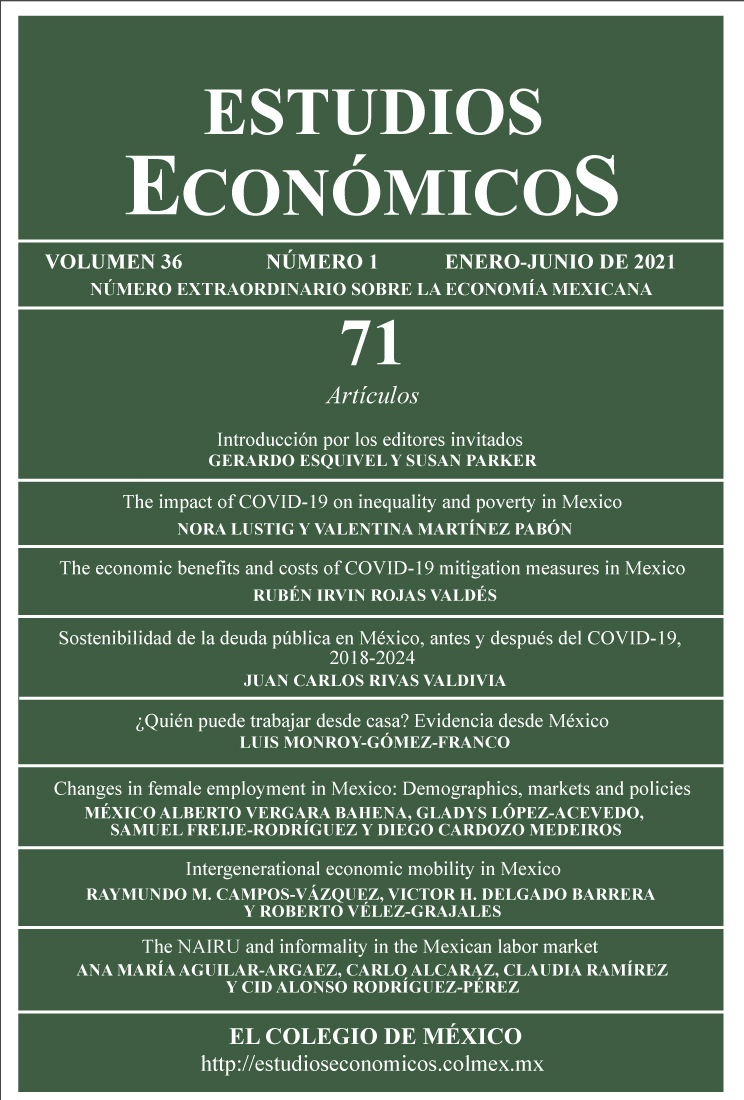Publicado 2021-01-14
Palabras clave
- desempleo,
- informalidad,
- NAIRU,
- ciclo económico
Cómo citar
Resumen
La tasa de desempleo no aceleradora de la inflación (NAIRU, por sus siglas en inglés) no es directamente observable y la presencia de trabajadores informales impone un desafío adicional en su estimación. En este artículo, presentamos una estimación de la NAIRU tradicional para México y una medida alternativa que incluye la informalidad como un indicador de subutilización laboral. Encontramos que ambas medidas de la NAIRU y los indicadores de holgura del mercado laboral asociados siguen patrones similares a lo largo del tiempo. Sin embargo, la holgura estimada con el indicador que incluye la informalidad parece predecir las presiones inflacionarias con mayor precisión cuando la brecha de desempleo es cercana a cero.
Descargas
Citas
- Alcaraz, C. 2009. Informal and formal labour flexibility in Mexico, Desarrollo y Sociedad, 63: 115-143.
- Alcaraz, C., D. Chiquiar, and A. Salcedo. 2015. Informality and segmentation in the Mexican labor market, Documento de Investigación No. 2015-25, Banco de México.
- Bai, J. and P. Perron. 2003. Computation and analysis of multiple structural change models, Journal of Applied Econometrics, 18(1): 1-22.
- Banco de México. 2008. Quarterly Report 2008Q1.
- Banco de México. 2009. Informe sobre la inflación, Abril-Junio 2009.
- Banco de México. 2012. Quarterly Report 2012Q4.
- Banco de México. 2016. Quarterly Report 2016Q4.
- Chiquiar, C. and M. Ramos-Francia. 1999. Desempleo y subempleo: opciones de política laboral, in F. Solís Soberón and F. Alejandro Villagómez (eds.), La Seguridad Social en México, Mexico City, Fondo de Cultura Económica.
- Esfahani, H.S. and D. Salehi-Isfahani. 1989. Effort observability and worker productivity: Toward an explanation of economic dualism, Economic Journal, 99(39): 818-836.
- Fajnzylber, P. and W. Maloney. 2007. Micro-firm dynamics and informality, in G.E. Perry, W.F. Maloney, O.S. Arias, P. Fajnzylber, A.D. Mason, and J. Saavedra-Chandunvi (eds.), Informality: Exit or Exclusion?, Washington, D.C., World Bank.
- Federal Labor Law, https://www.gob.mx/cms/uploads/attachment/file/156203/1044_Ley_Federal_del_Trabajo.pdf.
- Fiess, N.M., M. Fugazza, and W.F. Maloney. 2010. Informal self-employment and macroeconomic fluctuations, Journal of Development Economics, 91(2): 211-226.
- Gasparini, L. and L. Tornarolli. 2009. Labor informality in Latin America and the Caribbean: Patterns and trends from household survey microdata, Desarrollo y Sociedad, 63: 13-80.
- Gordon, R.J. 1997. The time-varying NAIRU and its implications for economic policy, Journal of Economic Perspectives, 11(1): 11-32.
- Hamilton, J.D. 1986. A standard error for the estimated state vector of a state space model, Journal of Econometrics, 33: 387-397.
- Hansen, P.R., A. Lunde, and J.M. Nason. 2011. The model confidence set, Econometrica, 79(2): 453-497.
- Hodrick, R.J. and E. Prescott. 1997. Postwar U.S. business cycles: An empirical investigation, Journal of Money, Credit and Banking, 29(1): 1-16.
- ILO. 2003. Seventeenth international conference of labour statisticians, Geneva, International Labour Office.
- INEGI. 2016. Encuesta nacional de ocupación y empleo (ENOE), Mexico.
- Laubach, T. 2001. Measuring NAIRU: Evidence from seven economies, The Review of Economics and Statistics, 83(2): 218-231.
- Maloney, W. 1999. Does informality imply segmentation in urban labor markets? Evidence from sectoral transitions in Mexico, The World Bank Economic Review, 13(2): 275-302.
- Meghir, C., R. Narita, and J.M. Robin. 2015. Wages and informality in developing countries, American Economic Review, 105(4): 1509-1546.
- Perry, G., W. Maloney, O. Arias, P. Fajnzylber, A. Mason, and J. Saavedra-Chanduvi. 2007. Informality: Exit and Exclusion, Washington D.C., World Bank.
- Peterson, P. 2014. Impacto del ciclo económico sobre las horas trabajadas en el sector formal e informal en México, Tesis de Licenciatura, ITAM.
- Restrepo, J.L. 2008. Estimaciones de la NAIRU para Chile, Economía Chilena, 11(2): 31-46.
- Staiger, D., J.H. Stock, and M.W. Watson. 1997a. How precise are estimates of the natural rate of unemployment in reducing inflation?, in C.D. Romer and D.H. Romer (eds.), Reducing Inflation: Motivation and Strategy, Chicago, University of Chicago Press.
- Staiger, D., J.H. Stock, and M.W. Watson. 1997b. The NAIRU, unemployment and monetary policy, Journal of Economic Perspectives, 11(1): 33-49.
- St-Amant, P. and S. Van Norden. 1997. Measurement of the output gap: A discussion of recent research at the Bank of Canada, Technical Reports No. 79, Bank of Canada.
- Stock, J. 1994. Unit roots, structural breaks and trends, in R. Enge and D. McFadden (eds.), Handbook of Econometrics, Vol. 4, 2739-2841, Elsevier.

